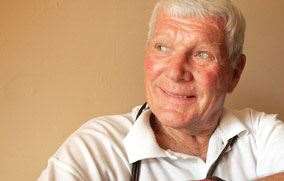George Daldry introduced new conditioning methods at a time when a game like rugby league was always going to frown upon a “fitness guru”.
 Newspix
NewspixGeorge Daldry introduced new conditioning methods at a time when a game like rugby league was always going to frown upon a “fitness guru”. When “joggers”were a source of ridicule, Daldry was one of the first to have the guts to “run in public”.
Daldry was the man for the times. To elite players he was that most admirable of men – a “man’s man” who’d exhibited a heroism sportsmen could only dream of. He was a philosopher, but not a man of public words; no “armchair” fitness expert ... the sport would’ve rejected him if he had been. He stopped training players in the 1980s with his reputation intact as the sort of trainer who never asked anyone to do anything he himself could not do. Now that’s a league man.
In 1938, at 16, Daldry ‒ a tough, fit kid who boxed at the local boys’ club ‒ was posted to Malaysia, captured by the Japanese and sent to the infamous Changi prison. He was imprisoned for four years, there and in Japan.
There are plenty of stories about Daldry’s courage and bigheartedness during these degrading and demanding times. But he was never going to tell them himself. There, in that place of grotesque horror, he became used to the taste of vomit and excrement (prisoners were forced to lick them from their boots) and the smell of burning flesh. Many gave up the ghost before they tasted the blade or perished in the blaze, but Daldry learned how to hang on to life.
One night in Changi, after a routine day of hard labour, Daldry decided he’d find the secret to longevity, strength and youthfulness. He found it, lived it and wanted desperately to pass it on. Upon his return to Sydney, he started right away, working with Sydney’s elite sportsmen.So rare was a character like Daldry in rugby league that just about everyone trained with him, and attributed their success to his methods.
Jack Gibson was the subject of our very first Innovator for the amazing work he did with Eastern Suburbs teams in the 1970s. What we didn’t say was that Gibson was making use of Daldry and his pioneering methods as far back as the 1960s, when Daldry was already working with the legendary St George sides. Bob Fulton used him as a trainer and conditioner for the Easts and Manly sides he coached from 1979-1987 and believed it was the unrivalled fitness of those teams that made the difference. Ron Coote, Bob McCarthy, Phil Hawthorne, members of many a Wallaby squad, including many of the World Cup-winning 1991 side, and many a Kangaroos side all pay tribute to Daldry’s methods.
He trained medal-winning Olympic and Commonwealth Games rowers, helped Lew Hoad recover from a career-threatening back injury, and Jimmy Carruthers to prepare for his world title fights.
It’s easy to portray Daldry as an “old-style”, hard-headed, no-nonsense fitness man who advocated lots of boxing, weights and running up stairs at Centennial Park. But what really characterised Daldry was his novel understanding of individual needs. His years in the war had given him a great empathy. In the 1980s he famously helped the towering, talented but troubled young Manly prop, Phil Daly, transforming him into a formidable and dynamic front rower through a personalised fitness routine.
Daldry’s book, Stopping The Clock, illustrates how versatile and original he was. Case studies abound, from people who got fit by working harder than they ever realised they could, to mums who lost weight by not exercising at all. He covers self-talk, assesses the range of fitness gadgetry and every fad, and talks with authority about the diets he’s tried on hundreds of disciples.
In fact, Stopping The Clock is simply one of the most startlingly useful fitness and health books you’ll ever read, just by virtue of its simplicity, breadth and applicability. Daldry went on to personally train luminaries like George H.W. Bush, Kerry Packer and Monaco’s Prince Albert. Even in his mid-80s he was considered one of the fittest and strongest men, year-for-year, in the country, and at 85 was still taking ten classes a week at the City Tattersalls Club, where he’d been an institution since 1958. He was also a fixture at North Bondi Surf Club for more than 50 years. Daldry gained rare recognition from the International Olympic Committee for his work.
Everyone who worked with him knew they’d met a special person – one of those true behind-the-scenes forces of nature who changed history and was known by anyonewho knew anything worth knowing. Before a debilitating hip injury a couple of years ago, Daldry was looking forward to resuming his routine. He was indomitable to the end. His clock stopped in December 2011, but he’d set in motion ‒ and turned back ‒ many others’ that still tick strongly.
‒ Robert Drane
Related Articles

Feature Story: Moving the Needle

The Aussies at The Open













